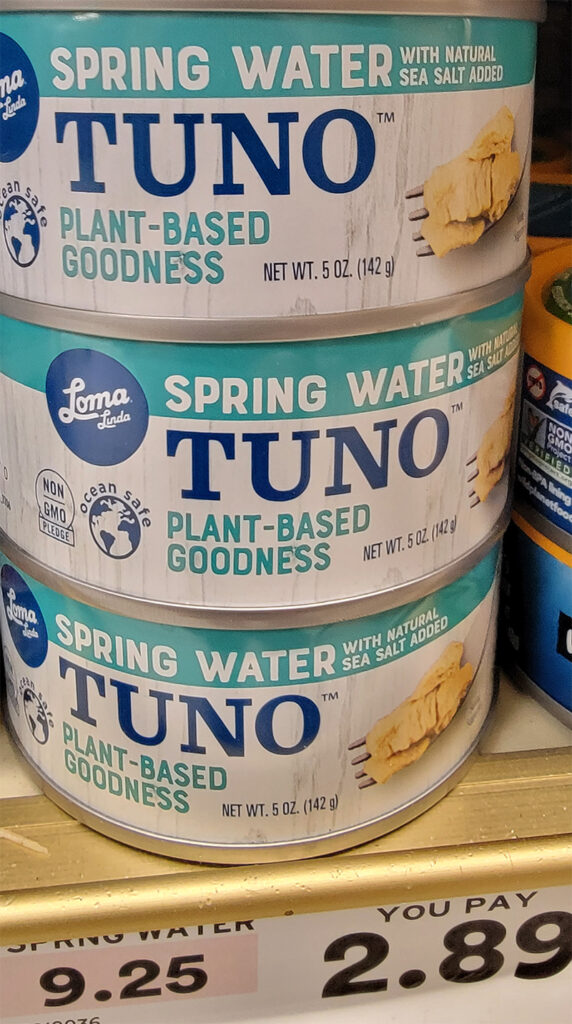
In 2022 we told you about a product put out by a company called Good Catch given the absurd name “fish-free tuna.”
Concocted out of pea protein isolate, soy protein concentrate, and several other brain-damaging, free glutamate ingredients, this product is one of several brands of fake “tuna” on supermarket shelves.
While most are in pouches, the latest faux tuna, TUNO, is deceptively marketed in a can to look as much like the real deal as possible. And that brings us to another tuna topic, one that’s a sucker punch to consumers. Only this time it’s aimed at those who eat actual tuna that came from a real fish.
Identity Theft
While researching the TUNO product we came across a curious Federal Register notice, a proposed rule issued by the FDA titled in part, “Canned Tuna Standard of Identity…”
A standard of identity, or SOI, is (or was) a way for consumers to be able to have assurances that certain foods are indeed what they claim to be. These FDA-enforceable rules were established way back in 1939 to make sure that peanut butter is made from peanuts and jam contains fruit.
The FDA currently has a legally binding SOI for foods ranging from pasta to bread to cheese and condiments, consisting of a detailed description of that food and what it can (or must) contain. Canned tuna is one of 250 items with a SOI.
The first SOI for canned tuna went into effect in 1958. According to the National Fisheries Institute, not a whole lot has changed since that time. But in 2015, three major manufacturers of canned tuna, StarKist, Chicken of the Sea, and Bumble Bee, filed a citizen petition with the FDA asking for alterations to that SOI.
Now to the casual observer, this FDA-proposed rule that was published in the Federal Register last August appears to be just a lot of industry lingo on how to weigh canned tuna, such as what the “standard of fill,” should be based on, and to utilize “drained weight” instead of “Pressed cake” weight.
But if you look carefully at what the FDA is proposing to do, based on that nine-year-old industry petition, there’s a lot in there about “flavorings.” In essence, this would allow for canned tuna to contain “any flavoring.” The FDA even proposed marking the words “seasonings and flavorings” for deletion, to be replaced with “optional ingredients.”
Now it’s not as if canned tuna was perfect to begin with. Plenty of noxious ingredients such as MSG are already allowed (if you haven’t read The Perfect Poison yet, get a copy and read chapters one and two). But this appears to go beyond what we’ve learned to look for when buying tuna, creating a mystery list of “flavorings” that could go unnamed in a canned tuna product.
Reading both the published notice and the industry petition doesn’t give much clarity. One section says: (except if flavoring is added, this paragraph applies only to the terms “_____ flavored” or “with _____ flavoring,” not to the constituent ingredients of that flavoring or to any optional solubilizing or dispersing ingredient used in connection with such flavoring ingredients)
That seems to indicate what comprises these unidentified flavorings or “optional ingredients” and their dispersing agents will not be disclosed, known only to the manufacturer. To try and further understand what this means, we reached out to the companies who gave the FDA this modified language.
Here’s what we found out!
Chicken of the Sea, which is represented by a publicity firm called Hunter PR, said our questions were too technical and we should take them to the FDA.
StarKist and Bumble Bee have yet to respond at all. At The National Fisheries Institute, it appears no one is yet available. And the FDA sent one email just saying they received our questions.
‘Evolving tastes and consumer preferences’
Of course, according to industry and the FDA, this is all for the benefit of the consumer! The FDA says that it will help “better meet evolving tastes and consumer preferences.” Industry says that this will “allow manufacturers to use flavorings that match the public’s changing tastes (and) help consumers increase their intake of seafood.”
Of the meager 17 comments on this notice, most were from industry partners applauding the changes. The National Consumers League (which calls itself “America’s pioneering consumer advocacy organization”) commended the FDA for this rulemaking saying it “greatly appreciates” all the trouble the agency went to for consumers and thanking them several times.
Only one commenter appeared to recognize the risks, stating that the “optional ingredient” provision could create “potential safety and allergen issues for consumers who may not be aware of what ingredients are added to canned tuna,” and “impair consumer rights.”
If we do get any of our questions answered on this, we’ll update it here. In the meantime, it appears that the FDA has not just handed over the keys to its headquarters to Big Food, it has stopped locking the doors entirely.


